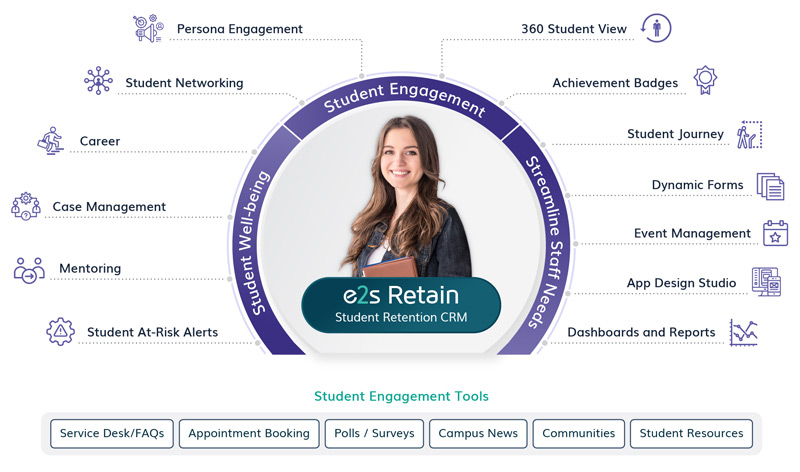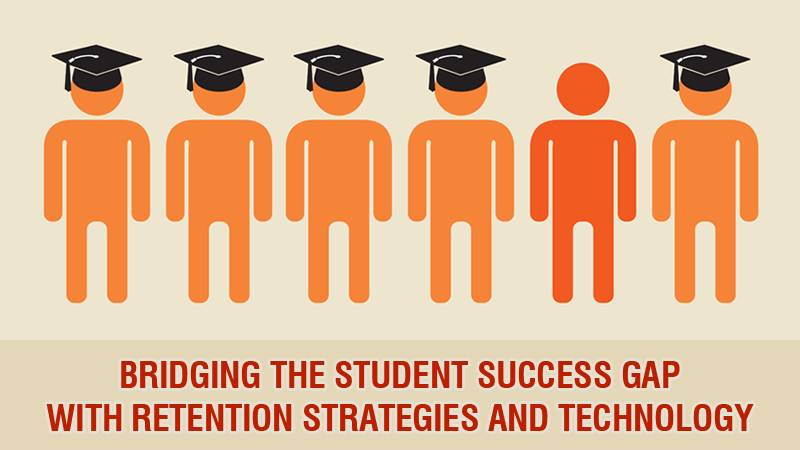Why is student retention success important?
Student retention rate is a critical metric in higher education. Universities and colleges measure student retention rate as the number of students who re-enroll from one year/term to the next.
Usually any student body boasts of diversity, spanning various age groups, demographics, race, gender, etc. Over the years, numerous theories have emerged regarding student retention success, recognizing the multifaceted needs of students. From financial assistance to balancing studies with work and family commitments, the challenges are diverse. Hence, it’s imperative to devise strategies that cater comprehensively to these needs.
Fortunately, innovative approaches such as advanced analytics, mobile technology utilization, video conferencing, and student-centric information portals are proving to be instrumental in maintaining student enrollment numbers, and progression towards graduation. Poor student retention leads to abysmal student success rates, which in turn affect both the institution’s brand equity and fund inflows.
Increasing Student Attrition rates and challenges
Higher education institutions face intense scrutiny based on their retention rates, and therefore, the issue of escalating student attrition rates adds to the pressure. It falls on the shoulders of decision-makers within colleges and universities to showcase their value by achieving notable student retention success.
Student retention involves devising a series of strategies to identify and intervene when students exhibit signs that they may not graduate. A college or university with a high graduation rate also has a high retention rate. The institution’s leadership would have to clearly spell out their vision of student success and communicate clear expectations to the campus stakeholders.
Bridging the gaps in Student Success with Retention Strategies and Technology Solutions
Several successful strategies have emerged to effectively engage students across diverse demographics. These strategies, which encompass the entire student body as well as specific groups, comprise a blend of traditional interventions and innovative technological solutions. Student engagement and student experience take center stage here.
In order to improve student retention, grasping two important underlying philosophies is of crucial importance. This also means that these have to be blended into the fabric of your campus culture.
a) know your student well; ensure that all those who deal with students have comprehensive information about each student in order to provide consistent service and responses, and
b) treat your student like a customer; any early student frustrations would make them look elsewhere, and thus increase attrition.
How can institutions improve student retention?
To improve student retention focus on student engagement and experience, and consider implementing the following strategies:
- Define student success: This needs to be done in no uncertain terms to all campus constituents. Institutional leadership would have to communicate clear expectations and share their vision of student success.
- Community Building: Foster strong campus communities both learning and leisure, inside and outside the classroom. These communities can be virtual either through the student portal or mobile apps for students to become enthusiastic contributors.
- New Student Orientation: Provide comprehensive orientation programs to familiarize students with campus resources, academic expectations, and support services. The sooner they know how they need to seek help the better.
- Safe Environment: Create a welcoming atmosphere where students feel comfortable participating and contributing, and in approaching campus staff for assistance. Student wellbeing ought to take center stage on the campus. This means student cases ought to be managed well, and need to be carefully as well as confidentially handled.
- Student referral: Faculty members and advisors must raise a student referral as soon as possible if they notice that the student is off path for any reason. The campus support team including case managers may jump in to intervene, act on it, track the outcomes, and put the student on the path to success.
- Success Seminars: Organize workshops and seminars focused on study skills, time management, and stress management to enhance student academic performance through online or physical workshops, followed up by a poll on the usefulness and relevance of the workshop.
- Career Development Programs: Offering career counseling, mentorship, internships, and job placement services to help students align their academic pursuits with their career goals. Involving your valuable alumni and making them central to student wellbeing will go a long way in providing the much-needed comfort to your students.
- Planning, Mentoring and Goal Setting: Assisting students to set academic goals, create personalized study plans, and track their progress towards degree completion. Providing guidance and support, for students through mentoring in a timely manner, greatly reduces the likelihood of dropout.
- Data Analytics: Monitor student progress and adjust strategies accordingly, looking at trends over time rather than just annual comparisons. Analytics help in developing superior campus support as well as resources that automatically enhance student self-service.
- Feedback Matters: Provide constructive and timely feedback to your students to encourage growth and perseverance. Sending ‘kudos messages’ to students is as important as helping them with their support needs. Enhance the quality and accessibility of remedial courses to support students with diverse learning needs.
- Student-Advisor Interactions: Facilitating regular meetings between students and academic advisors to provide personalized guidance and support throughout their academic journey. Easy access to student advisors is necessary for students to use self-appointed schedules.
- Accessible Data and Reporting: Utilizing data analytics to identify at-risk students, monitor their progress, and implement targeted interventions to support their success.
- Technologies to empower students: It’s just not enough to identify students at risk but its more critical to empower students and staff with technology solutions to transact, communicate, set up appointments, run events, mentor, and track outcomes – leading to successful closures of issues, questions, cases etc. Student portals/mobile technologies go a long way in creating vibrant communication among campus stakeholders and students, and even among students via virtual communities.
The pivotal question after devising these strategies is, “How can institutions encourage student participation?” Embracing technology becomes paramount in this aspect. Forward-thinking education professionals recognize the significance of mobile technology, acknowledging that many students primarily access campus resources through mobile devices. By creating a mobile-friendly student experience, institutions provide students with greater flexibility in their learning endeavors and student support, thereby enhancing engagement—a factor that correlates positively with retention rates.
Student retention success is not merely a goal but a necessity for higher education institutions aiming to foster student success and institutional growth. By implementing a combination of effective retention strategies and leveraging innovative technologies, colleges and universities can create an environment conducive to student engagement, persistence, and academic achievement.
Engage2Serve is a cloud-based Student Lifecycle CRM designed to help colleges recruit prospects, retain students, and engage alumni. Colleges and universities can leverage the power of mobile technology using the Engage2Serve mobile apps.
Student retention management solution e2s Retain from Engage2Serve, a student success CRM tool that identifies at-risk students in need of timely support and allows appropriate staff to efficiently collaborate on resolutions. Track everything from student attendance to grades, engagement to participation through a real-time student 360 view, a powerful single dashboard of each student’s campus progress and status, so that student support staff are well-informed and consistent in delivering their services.

Engage2Serve Inc. is the creator of transformational cloud-based, mobile-first Student Lifecycle CRM products for student recruitment, retention, and alumni engagement.


COMMENTS